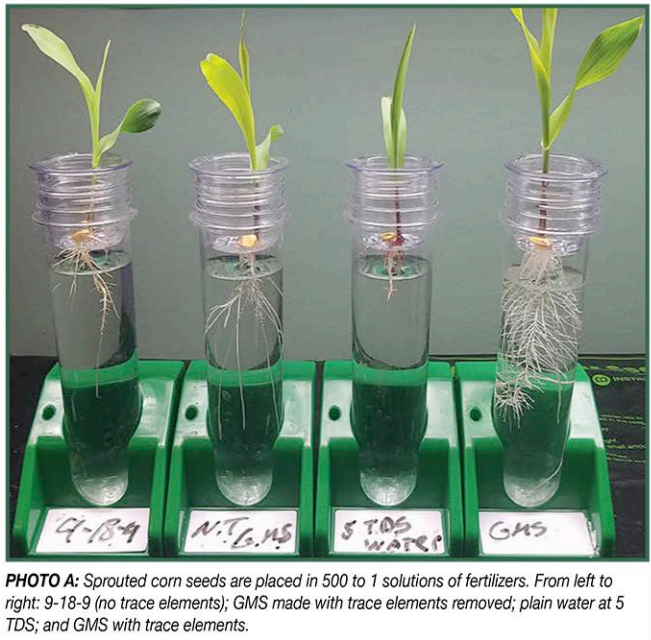A Visual Representation of the Value of Trace Elements
Since its initial creation by Dr. Victor Tiedjens, Growers Mineral Solution has contained a balanced package of trace elements (hereafter called micronutrients) that are added during the manufacturing process. This package was developed through hydroponics research, where Dr. Tiedjens needed to formulate a complete and balanced mixture of elements so as not to burn the roots of the plants. However, in order to keep the formula for GMS proprietary without patenting it, Dr. Tiedjens kept the exact recipe for the micronutrients a secret known only by those who absolutely needed to know. While this has protected his and Growers Mineral Corporation's primary asset, it also means that there is no documentation for us to point to when asked the question: What micronutrients are in Growers and why should we take your word that they are there?
For decades, there have been mountains of anecdotal evidence that there is much more than just nitrogen, phosphorus and potassium in GMS, but thanks to research by Matt Gooding, we now have more concrete evidence. As the saying goes, "The proof is in the pudding," and we have some excellent pudding to share with you.
Matt has tested several different fertilizer solutions against each other in both a hydroponics growth medium and a sand culture. He used a 9-18-9 liquid fertilizer, a control of pure water (5 T.D.S.), GMS without any micronutrients added, and regular GMS (containing micronutrients). Each solution was diluted to a ratio of 500 parts pure water to 1 part fertilizer. This is what was used in the hydroponics experiment, while in the sand culture the sand was watered one time with this dilution. For both experiments he used seed corn from open-pollinated corn, hand selected from the same cob and sprouted in water. The best sprouts were then selected to be used in the experiments. Please note that the 9-18-9 was chosen because, in past experiments comparing the properties of various liquid fertilizers, the 9-18-9 was closest to GMS in performance.
I will be going through and discussing both of these experiments, but we feel that the pictures of both speak a thousand words. The third leg of the Growers Program has always been self-verification, so seeing the striking differences in Photograph A (Hydroponics Experiment, see below) and Photograph B (Sand Culture Experiment, see Winter 2023 article) should catch the discerning farmer's eye.
HYDROPONICS EXPERIMENT
The visual difference in Photograph A is striking. When a plant is growing in the absence of soil, not only does all of its nutrition need to be applied, but it is also very susceptible to root burn from fertilizer toxicity. Therefore, fertilizers can show their true colors in a hydroponics setting. There are two comparisons I would like to draw your eye to: the first is between the GMS without micronutrients and the regular GMS. The only difference between these two vials is the micronutrient package yet see how much more and more robust root and top growth has occurred in the regular GMS vial. The second is between the 9-18-9 and GMS without micronutrients vials. Neither of these fertilizers contain any micronutrients (both are just NPK), so any difference in outcome must be from another factor. The GMS without micronutrients outperformed the 9-18-9 in root growth, both in terms of number of roots and root hairs, which will not grow in a toxic environment. Before we discuss why these differences occurred, please also see Table 1, where the weights of each sprout after three days of drying are recorded. Since most of the water has dried out of these sprouts, what you are looking at is dry weight taken mainly from nutrition, as the plant had not grown for a long enough time to create much carbohydrate weight through photosynthesis.
HYDROPONICS DISCUSSION
The beauty of a lab hydroponics experiment is that it allows us to control far more variables than in a field setting. In this experiment, the results we saw are almost entirely from the fertilizer solutions used. The first topic to discuss is why there is such a significant difference between the two GMS products. Both are made with the same clean raw ingredients, so the only difference is the micronutrient package. Some micronutrients, such as boron and zinc, are needed in higher quantities during germination and early growth, and both of these nutrients are present in GMS' micronutrient package. Their availability is plain: the root growth in the regular GMS has vastly outpaced all of its competition. Were GMS not a hot-mix product, or if we used less purified raw materials, I don't believe the roots would have been able to thrive as much as they have here. As it is, the roots were able and happy to absorb the nutrition they came into contact with. It should also be noted that there is no microbe presence in this experiment, so there is no factor of microbes making otherwise unavailable nutrients available. While the growth in the GMS without micronutrients vial has still done relatively well, it is functioning off NPK alone, which is clearly insufficient for optimal root growth.
However, the difference between regular GMS and the others does not end at the roots. The plant was able to translate the available nutrition into top growth. Many people think that nitrogen and potassium are the main factors in having large, green top growth. While this is true to an extent, all of the solutions here (barring the pure water) functionally have the same amount of nitrogen and potassium. There is surely a difference in availability, as we will discuss soon, but again the better top growth in the regular GMS must be chalked up to the micronutrient package. The roots had sufficient nutrition for the plant to put energy into top growth. Also notice the root hairs covering almost all of the roots. Root hairs are very sensitive to any impurities, so their presence is testament to GMS' cleanliness. They increase the surface area of the roots by a substantial amount, allowing for both more soil contact and, more importantly, a much larger rhizosphere (a 2-millimeter area around roots where soil microbes are most active). This will increase soil microbe health and plant nutrient absorption.
The second topic is the difference between the 9-18-9 and GMS without micronutrients. As far as nutrient amounts are concerned, these two fertilizers are virtually identical. However, there is a pretty significant difference in root growth. Notice how the 9-18-9 shot a tap root down but has had little growth besides that, whereas the GMS without micronutrients has roots of multiple purpose. This can't be chalked up to micronutrients but can be to raw material purity. GMS is made with technical grade raw materials, which means that the vast majority of impurities have been removed from the materials before we buy them. Additionally, the hot-mix process ensures uniformity of product and that the individual nutrients are tightly and chemically bonded with one another, so when one nutrient is absorbed, they all are. Technical grade raw materials and the hot-mix process are very expensive (and the hot-mix process can be dangerous), so most liquid fertilizers, likely including this 9-18-9, are cold-mixed and use some fertilizer grade raw materials. The results of going the cheaper route are clear.
This is an excerpt from the Winter Growers Solution (2023) written by Zach Smith, Product and Training Specialist.
Signup for our newsletter to stay in the loop


